NOTHING will literally kill your enjoyment of street machining like having a car fall on you. If you have any intention of working under your ride, a good jack and a good set (or two) of jack stands are absolutely mandatory.
We cannot stress it strongly enough — jack safety is a big deal. Back in 2013, the RACV website stated that in the previous four years at least 10 people died in Victoria, crushed under vehicles they were working on at home. I’ve had a car topple off a jack for no apparent reason and have also lost a friend when a car he was working on rolled off the car ramps and killed him after he unbolted the tailshaft. Even the ACCC has weighed in with its ‘Don’t be a jackass with jacks’ campaign.
So what should you buy and how should you use it? Let’s take a look.
1. WHICH JACK DO YOU NEED?
First and foremost, I recommend every enthusiast should buy a good trolley jack — sometimes referred to as a floor jack. Their versatility and ability to lift a vehicle to a decent height makes them the number-one choice. Spend the money and buy a good one; if you look after it, it’ll last you a lifetime.
At most, a jack is only ever lifting half your vehicle’s weight, so unless you’re crawling under something like a 3500kg 1958 Cadillac, units rated at one tonne (1000kg) or greater will be adequate for most streeters. Same goes for the jack stands.
2. SAFETY UNDER A VEHICLE
The term temporary citizens is often given to people working on cars not supported by jack stands. No matter how insignificant or quick the job, never place any part of your body under a vehicle that’s only supported by a jack. Always place it on a secure set of stands. I also like to place a wheel (or similar) under the sill panel, just in case the worst happens.
Similarly, never use stacks of bricks or wooden blocks as substitute stands. Prepare yourself with the correct tools for the job before you start.
When generous height is essential, find a hoist — they’re the ultimate jacks. They can be purchased for as little as $2000 or so, and are worth twice their weight in gold.
3. SAFETY STANDARDS AND CERTIFIED EQUIPMENT
Only buy and use approved jacks and jack stands (AS/NZS 2615:2004 for jacks; AS/NZS 2538:2004 for jack stands). Part of the Australian Standard requires them to be fitted with a huge sticker stating they have been certified to meet or exceed these standards. If it doesn’t have the sticker, it isn’t certified — end of argument. Again, only use certified equipment. Even if you’re on a tight budget, there are plenty of affordable certified models available.
4. ALLOY VERSUS STEEL JACKS
For the same lifting capacity, an alloy jack weighs less than a steel one — but it will also cost more. However, trolley jacks get wheeled around, not carried, so weight isn’t that big a deal. The exception is if you’re carting one around in the boot of your car and regularly unloading it offsite, such as at the race track. The range of bright anodised colours also makes alloy jacks look pretty.
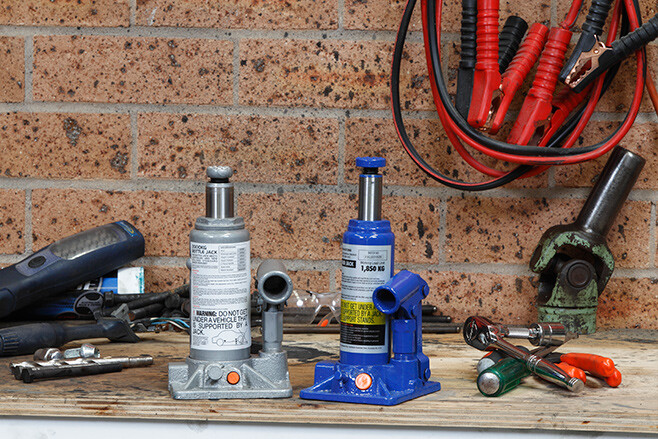 Although still popular in the truck industry, bottle jacks have few uses in the automotive trade other than emergency tyre changes; you’re much better off putting your money towards a good trolley jack
Although still popular in the truck industry, bottle jacks have few uses in the automotive trade other than emergency tyre changes; you’re much better off putting your money towards a good trolley jack
5. SUPPORTING A VEHICLE LONG TERM
All cars are flexible; older cars are very flexible. When placing stands under the chassis around the firewall area (ie, for easy access to the engine area) you’ll notice the car flex as the stands take up the weight — doors often become difficult to open or close as their frames slightly distort. For this reason it’s not a good idea to leave a car on stands for long periods of time; a day or so at the most.
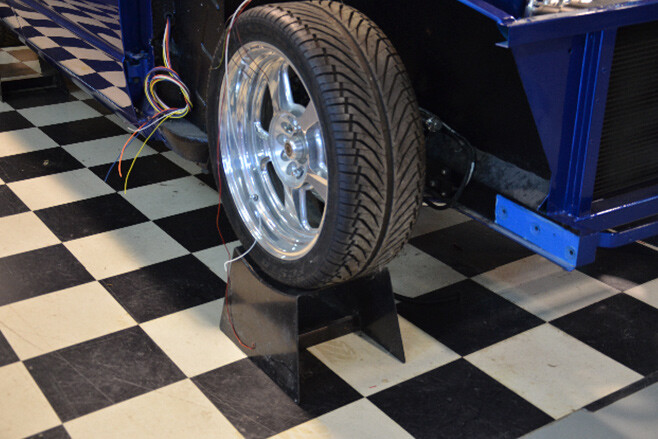 These owner-fabricated stands feature sturdy, steel construction and are ideal for supporting the vehicle for very long periods as they load the vehicle’s structure the same way as when parked
These owner-fabricated stands feature sturdy, steel construction and are ideal for supporting the vehicle for very long periods as they load the vehicle’s structure the same way as when parked
If you need to support the vehicle long term, such as when doing body work, it’s better to support both ends, either under the tyres, or at the same points where the suspension bears the weight of the vehicle.
Never leave a car sitting on the jack as this will ruin the hydraulic seals. Another way to ruin a perfectly good jack is dragging your car around on it — that’s a job for vehicle positioning jacks. Inappropriate and poorly maintained equipment is plain dangerous. If it leaks oil, repair or replace it and never use any jack that ‘sinks’. Don’t dump the vehicle off the jack either, as the fast action can cause the jack to slip. Lower it slowly and carefully, which allows you time to spot any potential hazards before they occur.
6. JACKING HINTS & TIPS
As you raise or lower a car, it travels in an arc which can cause the car to slide off the jack. As you raised one end, either the car’s wheels or the jack’s wheels must roll. Most often it’s the jack’s wheels. To facilitate this, line the jack up with the crossmember or diff and roll it directly into position. This ensures the jack’s wheels are facing in the correct direction and will roll without binding. Reverse the positioning action when lowering the vehicle and avoid shuffling the jack back and forth or wiggling it side-to-side into position, as its wheels will end up facing the wrong way.
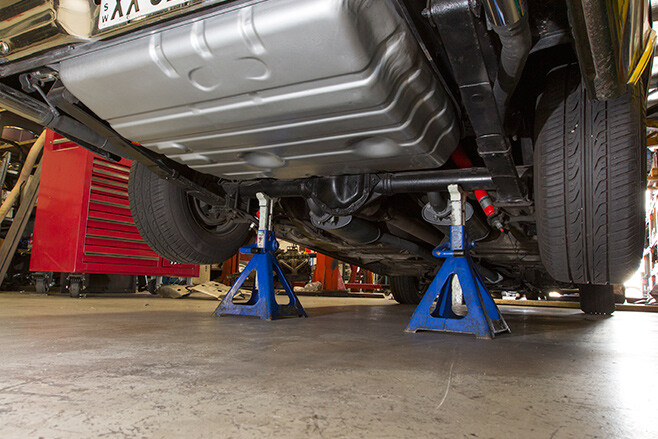 Under the diff’s axle tubes is an excellent location to place axle stands. As you lower a car onto stands, the vehicle’s angle will change, so double-check each stand’s position just before the vehicle makes contact with them
Under the diff’s axle tubes is an excellent location to place axle stands. As you lower a car onto stands, the vehicle’s angle will change, so double-check each stand’s position just before the vehicle makes contact with them
This is especially important if the car’s wheels at the opposite end have been chocked or one end of the vehicle is already sitting on stands, as the car then cannot roll. If your intention is to raise both ends, jack the diff up first and set it on stands, as the diff’s round axle tubes will more easily rotate atop the stands to account for the change in angle as the front is raised.
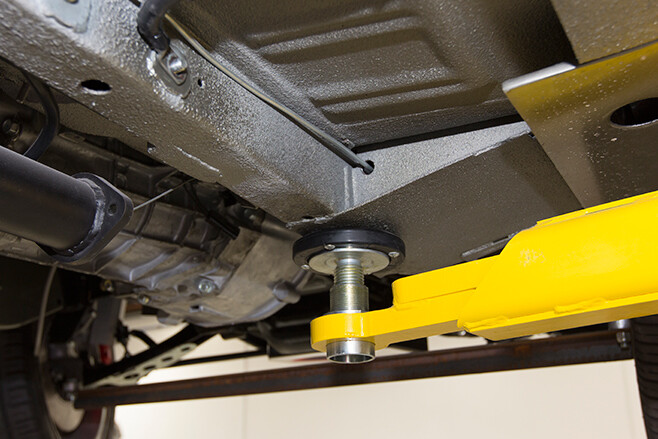 Note how this car is supported where multiple structural members meet – this is a very strong area on any vehicle. The section of chassis rail just to the rear of the support pad is an ideal location for a jack stand
Note how this car is supported where multiple structural members meet – this is a very strong area on any vehicle. The section of chassis rail just to the rear of the support pad is an ideal location for a jack stand
7. CAR SUPPORT & JACK POINTS
Front crossmembers and underneath the diff pumpkin are prime jacking points. While it’s possible to jack up one side only, the vehicle will be more stable if you jack up the front or rear as one unit and support it as such.
Note how this car is supported where multiple structural members meet – this is a very strong area on any vehicle. The section of chassis rail just to the rear of the support pad is an ideal location for a jack stand
As for support stand placement, they need to go under substantial structures – never under sheet metal. A rough rule of thumb is that if you think you can damage an area by smacking it with a hammer, it’s probably not substantial enough to act as a support point.
Areas where suspension components and gearbox crossmembers tie into the car’s main structure are good locations. Flat, level sections are paramount and the closer to the wheels the better.
8. POSITIONING THE JACK STAND
Virtually all jack stands have a V-section on top. Position the stands so the load sits down into the V — sitting on top of the V results in an extremely small contact area, which increases the possibility of the car slipping. Ideally, you want the support point to lock into the top of the jack stand, where it can’t slip.
As the car engages the stands, they can begin to tilt because the jack is still rolling. If this happens, raise the vehicle again, reposition the stands and try lowering it again — the stands must sit flat and never be tilted.
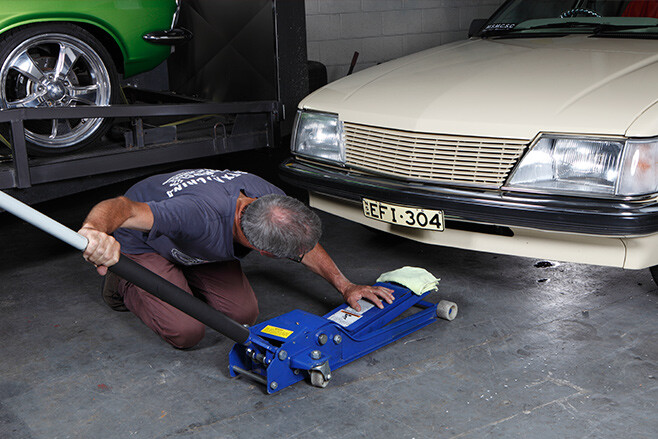 Some jacks feature a protective rubber pad. If yours doesn’t, a rag can be used to protect a nicely painted underside. However, this can obscure the top plate, so double-check it’s properly located under the jacking point and doesn’t just look like it is
Some jacks feature a protective rubber pad. If yours doesn’t, a rag can be used to protect a nicely painted underside. However, this can obscure the top plate, so double-check it’s properly located under the jacking point and doesn’t just look like it is
Vehicles with separate chassis offer many appropriate support points — as wide apart as possible and close to the wheels is ideal. With vehicles that use a monocoque construction, look underneath and you’ll see substantial sections that look like chassis rails. Place your jack stands under these sections.
9. BALANCING A VEHICLE
Think of your car as being balanced on the jack stands — if you can physically push it over, there’s a good chance it can and will inadvertently topple over by itself. So regardless of how well or securely you think you’ve placed the stands, always give the car a shake before getting under. It’s better it falls then than when you’re underneath trying to crack that ultra-tight ball joint.
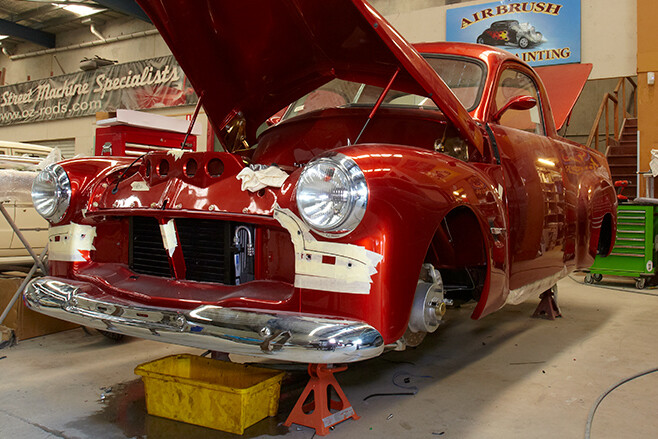 This ute is excellently supported – under the diff’s axle tubes and under the front crossmember where the lower control arms tie in. Always give the car a bit of shake to confirm it’s secure before climbing underneath
This ute is excellently supported – under the diff’s axle tubes and under the front crossmember where the lower control arms tie in. Always give the car a bit of shake to confirm it’s secure before climbing underneath
With a hoist, get the car up about 100mm and give it shake to ensure it’s securely supported. While you’re at it, try lifting the front and rear. If you can easily lift one end, drop the hoist down and reposition the arms for better weight distribution. A number of poorly positioned cars have toppled off hoists.
10. LEVEL GROUND
Never, ever jack up a car on anything other than flat, level ground. Ideally this should be concrete. Trolley jacks have been known to dig into bitumen, causing the car to slide off because the jack’s wheels can’t roll. The firmest of ground — even when reinforced with bricks or planks — can give way without notice, with lethal consequences, so always keep it safe and keep it on concrete.
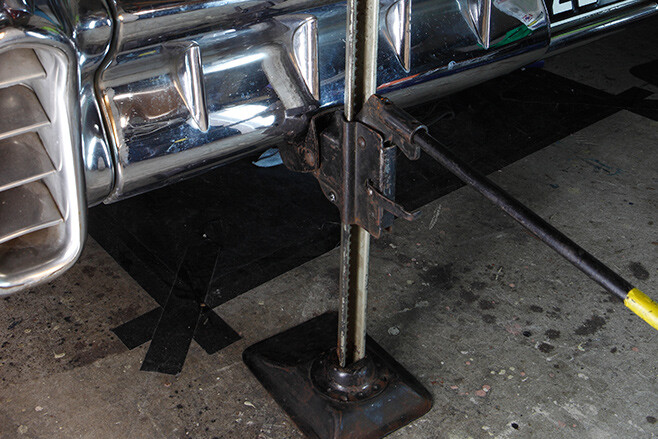 Factory-style bumper bar (above) and scissor jacks (below) are strictly for emergency wheel changes only – never use them for working on your streeter
Factory-style bumper bar (above) and scissor jacks (below) are strictly for emergency wheel changes only – never use them for working on your streeter
Yes, jacking up cars can be dangerous and it does sometimes claim lives. However, using the right equipment and a careful and diligent approach, crawling under your pride and joy won’t become a game of Russian Roulette.
11. JACK HEIGHT MATTERS
For me, the height a jack or stand can go to is the overriding attribute when making a purchasing decision. If you just want to pull a wheel off, almost any jack will do. However, if you want to get under your streeter and actually work on it, height matters. While you may not need the load capacity of the bigger truck-style jacks, they do offer superior lift height, which can be very handy, especially when extricating something like a diff or gearbox.
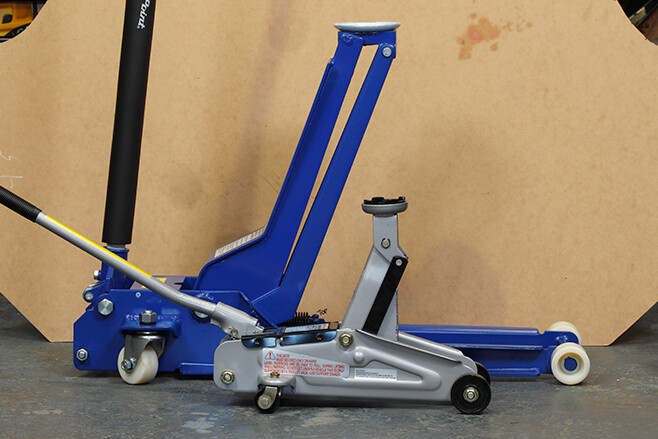 As long as its load rating is suitable for your vehicle, always go for the jack that lifts the highest. However, be aware that many high-lift jacks also have high minimum heights that won’t fit under a lowered car. The more expensive types are both low-profile and high lift. Both jacks pictured here are rated at 1000kg. Blue Point’s ultra-long reach (rear) is extremely low profile (just 68mm), yet lifts almost twice as high — a full 600mm. Unfortunately, it’s also five times the price of the Supercheap Auto unit in front.
As long as its load rating is suitable for your vehicle, always go for the jack that lifts the highest. However, be aware that many high-lift jacks also have high minimum heights that won’t fit under a lowered car. The more expensive types are both low-profile and high lift. Both jacks pictured here are rated at 1000kg. Blue Point’s ultra-long reach (rear) is extremely low profile (just 68mm), yet lifts almost twice as high — a full 600mm. Unfortunately, it’s also five times the price of the Supercheap Auto unit in front.
Now get out into the garage and get to it!
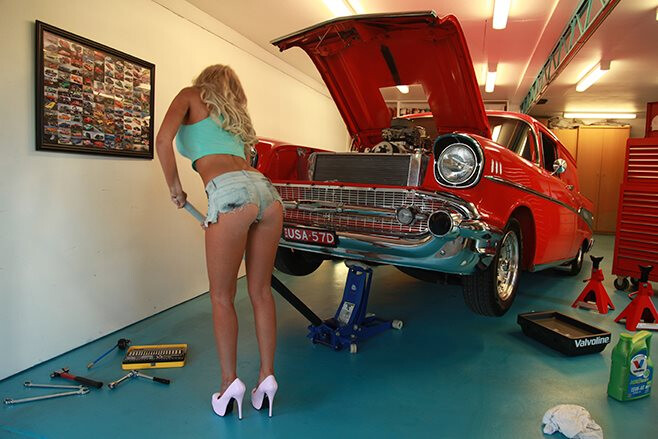
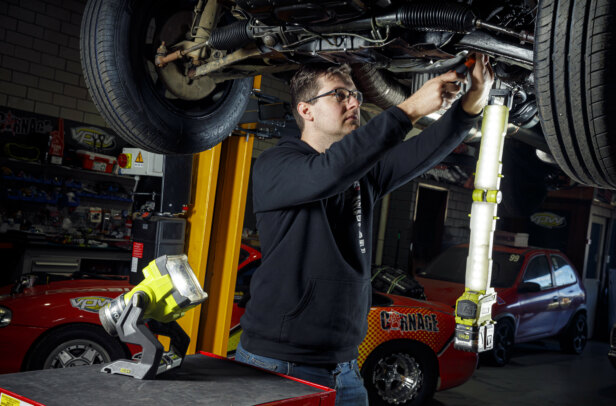
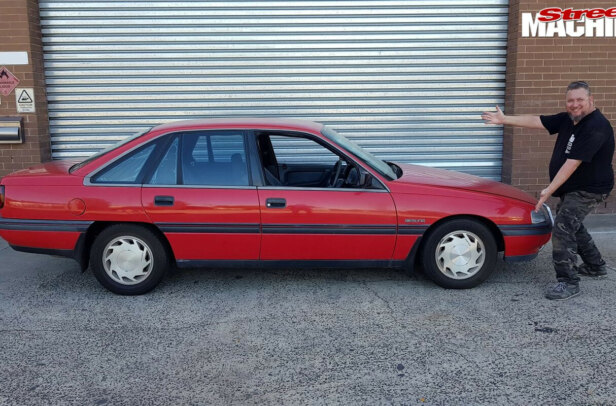
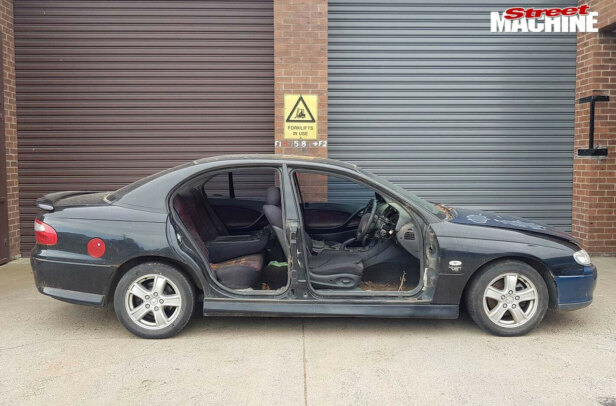
Comments